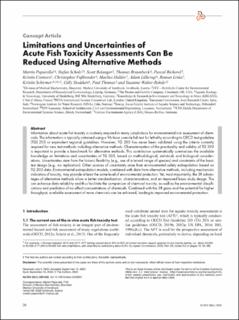Limitations and Uncertainties of Acute Fish Toxicity Assessments Can Be Reduced Using Alternative Methods
| dc.contributor.author | Paparella, Martin | |
| dc.contributor.author | Scholz, Stefan | |
| dc.contributor.author | Belanger, Scott | |
| dc.contributor.author | Braunbeck, Thomas | |
| dc.contributor.author | Bicherel, Pascal | |
| dc.contributor.author | Connors, Kristin | |
| dc.contributor.author | Faßbender, Christopher | |
| dc.contributor.author | Halder, Marlies | |
| dc.contributor.author | Lillicrap, Adam David | |
| dc.contributor.author | Liska, Roman | |
| dc.contributor.author | Schirmer, Kristin | |
| dc.contributor.author | Stoddart, Gilly | |
| dc.contributor.author | Thomas, Paul | |
| dc.contributor.author | Walter-Rohde, Susanne | |
| dc.date.accessioned | 2021-07-16T08:50:07Z | |
| dc.date.available | 2021-07-16T08:50:07Z | |
| dc.date.created | 2020-10-22T15:55:43Z | |
| dc.date.issued | 2021 | |
| dc.identifier.citation | Altex. 2021, 38 (1), 20-32. | en_US |
| dc.identifier.issn | 1868-596X | |
| dc.identifier.uri | https://hdl.handle.net/11250/2764617 | |
| dc.description.abstract | Information about acute fish toxicity is routinely required in many jurisdictions for environmental risk assessment of chemicals. This information is typically obtained using a 96-hour juvenile fish test for lethality according to OECD test guideline (TG) 203 or equivalent regional guidelines. However, TG 203 has never been validated using the criteria currently required for new test methods including alternative methods. Characterization of the practicality and validity of TG 203 is important to provide a benchmark for alternative methods. This contribution systematically summarizes the available knowledge on limitations and uncertainties of TG 203, based on methodological, statistical, and biological considerations. Uncertainties stem from the historic flexibility (e.g., use of a broad range of species) and constraints of the basic test design (e.g., no replication). Other sources of uncertainty arise from environmental safety extrapolation based on TG 203 data. Environmental extrapolation models, combined with data from alternative methods, including mechanistic indicators of toxicity, may provide at least the same level of environmental protection. Yet, most importantly, the 3R advantages of alternative methods allow a better standardization, characterization, and an improved basic study design. This can enhance data reliability and thus facilitate the comparison of chemical toxicity, as well as the environmental classifications and prediction of no-effect concentrations of chemicals. Combined with the 3R gains and the potential for higher throughput, a reliable assessment of more chemicals can be achieved, leading to improved environmental protection. | en_US |
| dc.language.iso | eng | en_US |
| dc.rights | Navngivelse 4.0 Internasjonal | * |
| dc.rights.uri | http://creativecommons.org/licenses/by/4.0/deed.no | * |
| dc.title | Limitations and Uncertainties of Acute Fish Toxicity Assessments Can Be Reduced Using Alternative Methods | en_US |
| dc.type | Peer reviewed | en_US |
| dc.type | Journal article | en_US |
| dc.description.version | publishedVersion | en_US |
| dc.rights.holder | © The Authors, 2020 | en_US |
| dc.source.pagenumber | 20-32 | en_US |
| dc.source.volume | 38 | en_US |
| dc.source.journal | Altex | en_US |
| dc.source.issue | 1 | en_US |
| dc.identifier.doi | 10.14573/altex.2006051 | |
| dc.identifier.cristin | 1841598 | |
| cristin.ispublished | true | |
| cristin.fulltext | original | |
| cristin.qualitycode | 1 |
Files in this item
This item appears in the following Collection(s)
-
Publikasjoner fra Cristin - NIVA [2160]
-
Scientific publications [1172]

